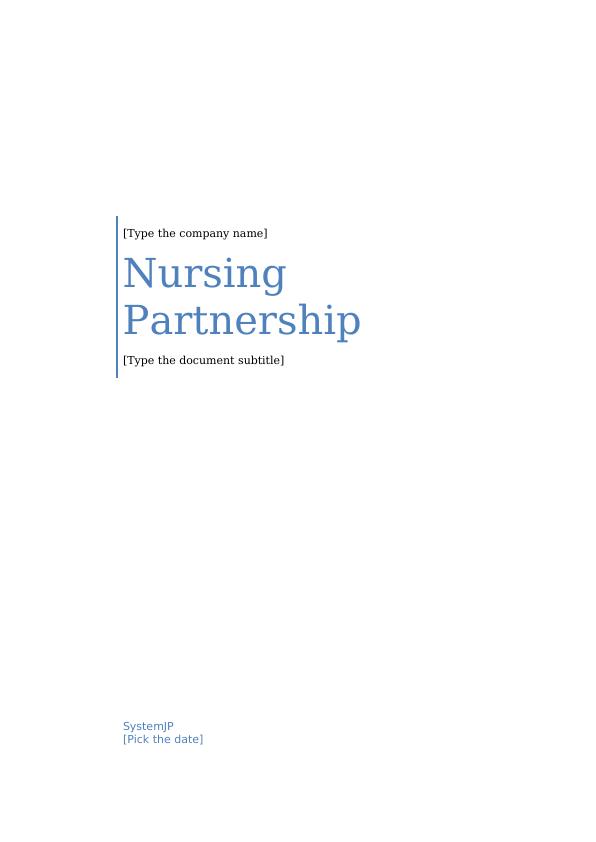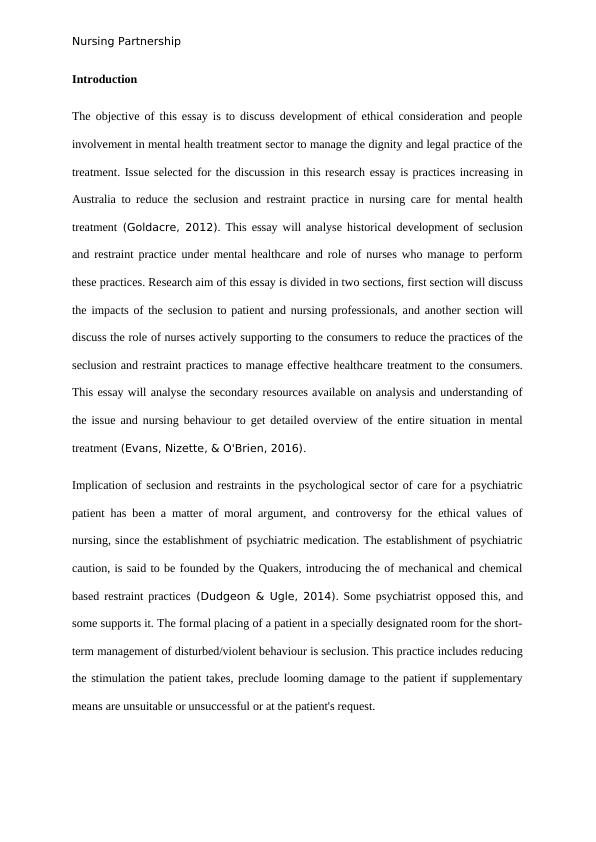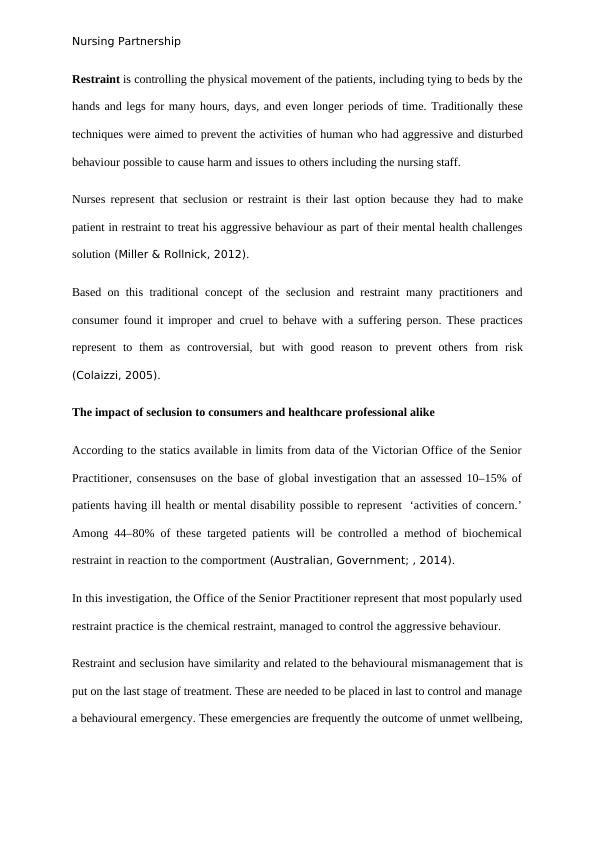Community College Nursing Partnership
8 Pages2279 Words18 Views
Added on 2022-09-08
Community College Nursing Partnership
Added on 2022-09-08
ShareRelated Documents
[Type the company name]
Nursing
Partnership
[Type the document subtitle]
SystemJP
[Pick the date]
Nursing
Partnership
[Type the document subtitle]
SystemJP
[Pick the date]

Nursing Partnership
Introduction
The objective of this essay is to discuss development of ethical consideration and people
involvement in mental health treatment sector to manage the dignity and legal practice of the
treatment. Issue selected for the discussion in this research essay is practices increasing in
Australia to reduce the seclusion and restraint practice in nursing care for mental health
treatment (Goldacre, 2012). This essay will analyse historical development of seclusion
and restraint practice under mental healthcare and role of nurses who manage to perform
these practices. Research aim of this essay is divided in two sections, first section will discuss
the impacts of the seclusion to patient and nursing professionals, and another section will
discuss the role of nurses actively supporting to the consumers to reduce the practices of the
seclusion and restraint practices to manage effective healthcare treatment to the consumers.
This essay will analyse the secondary resources available on analysis and understanding of
the issue and nursing behaviour to get detailed overview of the entire situation in mental
treatment (Evans, Nizette, & O'Brien, 2016).
Implication of seclusion and restraints in the psychological sector of care for a psychiatric
patient has been a matter of moral argument, and controversy for the ethical values of
nursing, since the establishment of psychiatric medication. The establishment of psychiatric
caution, is said to be founded by the Quakers, introducing the of mechanical and chemical
based restraint practices (Dudgeon & Ugle, 2014). Some psychiatrist opposed this, and
some supports it. The formal placing of a patient in a specially designated room for the short-
term management of disturbed/violent behaviour is seclusion. This practice includes reducing
the stimulation the patient takes, preclude looming damage to the patient if supplementary
means are unsuitable or unsuccessful or at the patient's request.
Introduction
The objective of this essay is to discuss development of ethical consideration and people
involvement in mental health treatment sector to manage the dignity and legal practice of the
treatment. Issue selected for the discussion in this research essay is practices increasing in
Australia to reduce the seclusion and restraint practice in nursing care for mental health
treatment (Goldacre, 2012). This essay will analyse historical development of seclusion
and restraint practice under mental healthcare and role of nurses who manage to perform
these practices. Research aim of this essay is divided in two sections, first section will discuss
the impacts of the seclusion to patient and nursing professionals, and another section will
discuss the role of nurses actively supporting to the consumers to reduce the practices of the
seclusion and restraint practices to manage effective healthcare treatment to the consumers.
This essay will analyse the secondary resources available on analysis and understanding of
the issue and nursing behaviour to get detailed overview of the entire situation in mental
treatment (Evans, Nizette, & O'Brien, 2016).
Implication of seclusion and restraints in the psychological sector of care for a psychiatric
patient has been a matter of moral argument, and controversy for the ethical values of
nursing, since the establishment of psychiatric medication. The establishment of psychiatric
caution, is said to be founded by the Quakers, introducing the of mechanical and chemical
based restraint practices (Dudgeon & Ugle, 2014). Some psychiatrist opposed this, and
some supports it. The formal placing of a patient in a specially designated room for the short-
term management of disturbed/violent behaviour is seclusion. This practice includes reducing
the stimulation the patient takes, preclude looming damage to the patient if supplementary
means are unsuitable or unsuccessful or at the patient's request.

Nursing Partnership
Restraint is controlling the physical movement of the patients, including tying to beds by the
hands and legs for many hours, days, and even longer periods of time. Traditionally these
techniques were aimed to prevent the activities of human who had aggressive and disturbed
behaviour possible to cause harm and issues to others including the nursing staff.
Nurses represent that seclusion or restraint is their last option because they had to make
patient in restraint to treat his aggressive behaviour as part of their mental health challenges
solution (Miller & Rollnick, 2012).
Based on this traditional concept of the seclusion and restraint many practitioners and
consumer found it improper and cruel to behave with a suffering person. These practices
represent to them as controversial, but with good reason to prevent others from risk
(Colaizzi, 2005).
The impact of seclusion to consumers and healthcare professional alike
According to the statics available in limits from data of the Victorian Office of the Senior
Practitioner, consensuses on the base of global investigation that an assessed 10–15% of
patients having ill health or mental disability possible to represent ‘activities of concern.’
Among 44–80% of these targeted patients will be controlled a method of biochemical
restraint in reaction to the comportment (Australian, Government; , 2014).
In this investigation, the Office of the Senior Practitioner represent that most popularly used
restraint practice is the chemical restraint, managed to control the aggressive behaviour.
Restraint and seclusion have similarity and related to the behavioural mismanagement that is
put on the last stage of treatment. These are needed to be placed in last to control and manage
a behavioural emergency. These emergencies are frequently the outcome of unmet wellbeing,
Restraint is controlling the physical movement of the patients, including tying to beds by the
hands and legs for many hours, days, and even longer periods of time. Traditionally these
techniques were aimed to prevent the activities of human who had aggressive and disturbed
behaviour possible to cause harm and issues to others including the nursing staff.
Nurses represent that seclusion or restraint is their last option because they had to make
patient in restraint to treat his aggressive behaviour as part of their mental health challenges
solution (Miller & Rollnick, 2012).
Based on this traditional concept of the seclusion and restraint many practitioners and
consumer found it improper and cruel to behave with a suffering person. These practices
represent to them as controversial, but with good reason to prevent others from risk
(Colaizzi, 2005).
The impact of seclusion to consumers and healthcare professional alike
According to the statics available in limits from data of the Victorian Office of the Senior
Practitioner, consensuses on the base of global investigation that an assessed 10–15% of
patients having ill health or mental disability possible to represent ‘activities of concern.’
Among 44–80% of these targeted patients will be controlled a method of biochemical
restraint in reaction to the comportment (Australian, Government; , 2014).
In this investigation, the Office of the Senior Practitioner represent that most popularly used
restraint practice is the chemical restraint, managed to control the aggressive behaviour.
Restraint and seclusion have similarity and related to the behavioural mismanagement that is
put on the last stage of treatment. These are needed to be placed in last to control and manage
a behavioural emergency. These emergencies are frequently the outcome of unmet wellbeing,

End of preview
Want to access all the pages? Upload your documents or become a member.
Related Documents
Australia’s Public Mental Health Systemlg...
|13
|3217
|30
Restraint Practices in Mental Healthlg...
|11
|3181
|38
Journal of Korean Academy of Psychiatriclg...
|10
|2698
|14
NSM5CPR - Clinical Practice Development, Seclusionlg...
|24
|7229
|31
Overview of Seclusion in Mental Healthlg...
|13
|3301
|23
Role of Nurses in Reduction of Seclusion - Deskliblg...
|6
|454
|402
